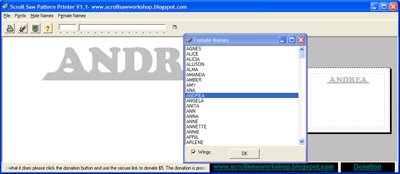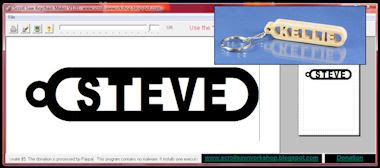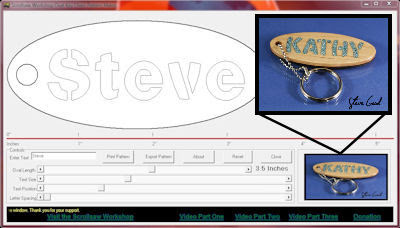Sue Mey is a scroll saw artists and pattern designer from
The scroll saw is not Sue's only creative outlet, she also enjoys wood carving, photography and many other crafts. Sue's love of animals shows in her patterns. Please take some time and visit Sue's website to get an ideal of just how creative and prolific this talented designer really is. http://www.scrollsawartist.com
Sue has graciously granted me the opportunity to ask her a few questions to give us some insight into her creative process.
(SW)Sue thanks for taking time out of your schedule to talk with us. Could you tell us a little about your artistic background and what brought you to the scroll saw?
(Sue)Hi Steve and thanks for the opportunity!
I’ve always been interested in art & crafts. At one stage I specialized in watercolor painting and pastels. About five years ago I entered the craft market in a big way and did all sorts of crafts for stores – wire, tin, beading, tole painting, decoupage, sewing crafts etc. And wood… there was always wood ~smile~. I saw scroll sawing demonstrated at a show about 14 years ago and decided to try it. My first saw was a Delta and after cutting some stand-up puzzles I was thoroughly hooked. I upgraded to a Hegner soon after that and never looked back. I LOVE scroll sawing!
(SW)You are a very prolific designer. Where do you generally get the inspiration for new patterns?
(Sue)My inspiration comes from multiple sources and I seem to go through stages. Lately I have been doing a lot of Paint Shop Pro drawing. Not every drawing is a success and sometimes I spend hours on a drawing just to shelve it. Others are quicker to draw, so they balance the time lost on the disastrous ones. Up to five months ago my main source of inspiration was photographs and I still use them, especially for animal portraits. I am fortunate to be able to photograph my favorite subject, the leopard, and other wild animals, in their natural habitat.
Certain patterns start as an idea in my head; I get some brilliant ideas just before I go to sleep at night – the frustrating thing is that some mornings I wake up and know it was a great idea, but cannot remember what it was. One starts to look at every object as a possible scroll saw pattern – the reflection in a glass of soda that would make an excellent trinket box lid, the scrolls in a cast iron staircase that would be perfect in a Victorian picture frame…it can become quite incommodious!
I also look at what type of patterns are not yet available on the market and try to take advantage of that. On the other side of the coin, I make my own versions of popular types of patterns that have been made by others, so that I have a variety available on my website, to appeal to a broader customer base. If a certain genre of pattern proves popular, I develop more patterns along the same lines. Then there are also the patterns that are developed on request by customers i.e. “I need a Husky dog” or “Can you make me a BMW R1150GS motorcycle?”
(SW)On average how many hours would you say it takes from the idea, to the finished pattern which you sell on your website?
(Sue)Now and then I will complete a pattern within 30 minutes but most take a lot longer than that. I have been known to work on a pattern intermittently for many months before I was satisfied with the result. It all depends on the success of the process to put the idea into a cut-able pattern – some ideas work straight away and others need a lot more effort.
(SW)Which do you find more difficult, coming up with the idea or actually designing the pattern?
(Sue)Ideas are plentiful and abundant – designing the scroll saw plan is definitely the harder part of pattern making.
(SW)What tools do you use to design your patterns? Could you tell us a little bit about how you use each tool?
(Sue)As I get those ideas from things around me, I make rough drawings in a note book. I then use a drawing board, drawing pad, sharp, soft pencil and eraser to put them on paper. Once I am happy with the result, I use a fine-tipped drawing pen on the lines and then I scan the image into my PC at 300 dpi, with the “unsharp mask” setting ticked. The image is imported into PSP or Photoshop and modified into a pattern as described below.
Some patterns are drawn in Paint Shop Pro, combining preset shapes, picture fonts and text. Since these are vector based images, one can enlarge and scale to suit before turning the finished result into a raster image. I like to do my basic drawings in PSP and then open the image in Photoshop for modification and manipulation.
For photographs I use mainly Photoshop. Obviously there are many tools and actions one can use to make a pattern, but it can get quite lengthy and complicated so I will discuss some basic procedures here. Good quality, high resolution images work best. The digital image is opened in PS and turned to grayscale. The first thing I do is to duplicate the image and save it using a new file name, so that the original remains unaltered. I then change the image size/canvass size to a standard dimension i.e. 8” x 10” and the dpi to 300. The next step is to adjust the brightness/contrast to see which lines and areas need to be added, thickened or erased. Undo the brightness/contrast and work on these areas with the pen tool, using black to add and white to erase. Sometimes you need to draw in certain areas and add your own lines to make the pattern work. Be careful not to leave too many “squiggles” on the edges of black (cut) areas, rather smooth out the edges using black or white. This makes for a neater pattern. The smallest pen tool sizes I use are 3 for vein lines and 6 for areas where a blade entry hole has to be made. Use the brightness/contrast adjustment at regular intervals to see the result, but undo the adjustment each time until you are satisfied with the results of your modifications to the image. Make sure that there are no “floaters” (white areas surrounded by black) anywhere in the pattern. At this stage I print the pattern to see how I’m doing and make more adjustments. For some photos the Filters>Sketch>Photocopy adjustment also works quite well.
Parts of the pattern can be moved, skewed or rotated by encircling it with the lasso tool and then using the move tool or the edit>transform actions. Certain elements or portions of other images/photos can be incorporated in the pattern by using copy>paste. Each ‘paste’ action places the image portion on your pattern as a separate layer, where you can make modifications. Once you are satisfied with its position, use layers>flatten image to merge the image bits into the main pattern.
(SW)Let's change the focus here just a little bit. An interesting thing that I have noticed since writing my blog is the large number of women that enjoy scrolling. Do you have any opinions as to why so many women are attracted to this form of woodworking?
(Sue)I think the scroll saw is a much safer tool than many other woodworking tools and therefore less intimidating to female beginners. Many female scrollers have expressed the opinion that they find it easy because of the correlation in working action between a scroll saw and a sewing machine. At a woodworking show, more women are inclined to try a scroll saw, than for instance, a router. However, in my experience, it normally does not take very long for the ladies to move on to learning other tools like the table saw, disc/belt sander and router.
Another reason may be that because scroll sawing demands a certain amount of patience and persistence, women generally do well with this form of woodworking.
(SW)I know you also teach scroll saw classes. What are your two favorite tips for people just getting started with their scroll saw?
(Sue)Most people have not yet bought a saw when they do the class, so to them I always advise to buy the best saw they can afford. I have seen so many prospective scrollers throw in the towel because they did not find it a pleasurable activity. In all cases the reason for conceding defeat was an inferior, low-end scroll saw. One cannot enjoy using a saw that vibrates excessively or that will not hold a blade properly…Or working with a saw that restricts you to cutting profiles with a quarter inch wide pin-end blade, when you’d really like to cut delicate fretwork. Furthermore, the quality of the scroll saw is reflected in the end result of the project and people are often disappointed with their completed projects.
I guess the second tip has to be “practice, practice, practice” – as with any new activity one starts… be it driving a motorcar or using a new software program, one gets better at it with practice. Do not be discouraged if the circles are not perfect or you have a problem staying on the pattern lines; just keep at it and every project you undertake will be better than the previous one.
(SW)I read on your website that you use a Hegner scroll saw. I get questions every week asking which scroll saws I recommend. Would you recommend the Hegner saw? Could you also give us some of your likes and dislikes about the saw?
(Sue)I enjoy my two Hegner saws tremendously. I have never worked with an Excalibur, Hawk, Dremel or Diamond so I cannot compare, but have had the opportunity to put a DeWalt through its paces for a week. I have also used Proxxon and Delta saws. My one Hegner saw has been running for 14 years now and I have not had a moment’s trouble with it. The only maintenance required is lubricating the upper and lower arm bearings from time to time. The one part that can be improved upon is the dust blower which is not very effective – I replaced mine with a gooseneck-type blower tube. The Hegner runs quietly, cuts smoothly, and has an easy blade change system as well as the added ease of a quick blade clamp for use in making multiple inside cuts.
(SW)The other question that everybody always asks is which brand of scroll saw blade I use. Which brand do you use and what are your favorite types of blades?
(Sue)Over the years I have imported various brands of scroll saw blades. Now I use
(SW)Okay here is an important one. Do you listen to music while you saw and if so what kind of music?
(Sue)Yes, all the time – the type of music I listen to depends on my mood and the type of project I work on. It varies from Mozart’s piano concertos to 60s and 70s rock like Jethro Tull, Toto, Deep Purple and Led Zeppelin. The selections are balanced with contemporary varieties such as Seal, Nelly Furtado and Michael Buble. I also enjoy Latin American music from
(SW)Sue I really appreciate you taking the time to share your thoughts on scrolling with my visitors at the Scrollsaw Workshop. Is there anything else you would like to add before we wrap up?
(Sue)I would just like to say that for the most part, the scroll sawing community is a wonderful group of people and many have been generous with their feedback and praise for my work. I appreciate this sincerely and hope that I will be able to continue to make my small contribution to this industry that I take so much pleasure in, for a long time to come.
I have some free patterns available for download on my website and will be adding new ones on a regular basis. To be kept updated of special offers or new patterns added to my site, join the mailing list by dropping me a line. Thank you!
Website: www.scrollsawartist.com
Email: sue@scrollsawartist.com

























